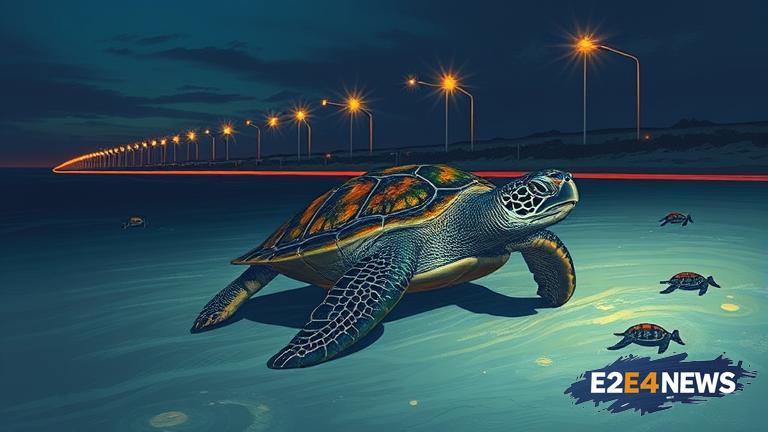Sea turtles have been navigating the world’s oceans for over 100 million years, but their ancient migration patterns are being disrupted by a modern phenomenon: interstate lights. A recent study has found that the glow from these lights is causing sea turtles to become disoriented, leading them away from their natural habitats and into danger. The study, which was conducted by a team of researchers from the University of Florida, used satellite imagery and field observations to track the movement of sea turtles along the eastern seaboard of the United States. The results showed that the turtles were being drawn to the bright lights of interstate highways, which were confusing them and causing them to lose their way. This is a major concern for conservationists, as sea turtles are already vulnerable to a range of threats, including habitat destruction, pollution, and climate change. The loss of these incredible creatures would not only be a tragedy, but it would also have significant ecological implications. Sea turtles play a vital role in maintaining the health of our oceans, and their disappearance could have a ripple effect throughout the entire ecosystem. The study’s findings have sparked calls for action, with many advocating for the use of turtle-friendly lighting on interstate highways. This could involve using special filters or shields to reduce the glare from the lights, or implementing smart lighting systems that can be adjusted to minimize the impact on sea turtles. Some states have already begun to take steps to address the issue, with Florida and Georgia introducing legislation to reduce the impact of interstate lights on sea turtle habitats. However, more needs to be done to protect these incredible creatures. The problem is not limited to the United States, with sea turtles around the world facing similar threats from coastal development and light pollution. In Australia, for example, the government has introduced measures to reduce the impact of light pollution on sea turtle habitats, including the use of special lighting and the creation of turtle-friendly beaches. Similarly, in the UK, conservationists are working to reduce the impact of coastal development on sea turtle populations, through the use of habitat restoration and wildlife-friendly lighting. The issue of interstate lights and sea turtles is a complex one, and it will require a coordinated effort from governments, conservationists, and the general public to address. However, with the right approach, it is possible to reduce the impact of these lights and protect the habitats of these incredible creatures. The first step is to raise awareness about the issue, and to educate people about the importance of sea turtle conservation. This can be done through a range of initiatives, including public outreach programs, educational materials, and social media campaigns. Additionally, governments and conservation organizations can work together to develop and implement effective solutions, such as the use of turtle-friendly lighting and habitat restoration. The private sector also has a role to play, with companies able to make a positive impact by adopting sustainable practices and reducing their environmental footprint. Ultimately, the protection of sea turtles and their habitats will require a long-term commitment to conservation and sustainability. By working together, we can make a difference and ensure the survival of these incredible creatures for generations to come. The study’s findings have significant implications for our understanding of the impact of human activity on the environment, and highlight the need for urgent action to protect our planet’s precious wildlife. As we continue to urbanize and develop our coastlines, it is essential that we take steps to mitigate the impact of our activities on the environment. This can be done through the use of sustainable practices, such as renewable energy and eco-friendly lighting, as well as through the protection and restoration of natural habitats. By taking a proactive approach to conservation, we can help to reduce the impact of human activity on the environment and protect the incredible diversity of life on our planet. The issue of interstate lights and sea turtles is just one example of the many ways in which human activity is impacting the environment, and it highlights the need for a coordinated approach to conservation. By working together, we can make a difference and ensure the long-term survival of our planet’s precious wildlife.





